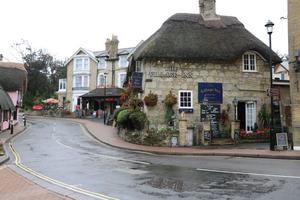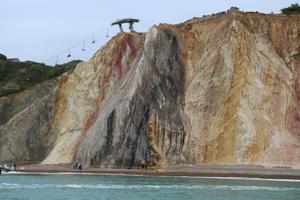If you want an overseas holiday but don’t fancy going far then the Isle of Wight ticks all the right boxes.
At Portsmouth we hopped on an Isle of Wight Tours coach for the forty minute Wightlink ferry crossing to Fishbourne and were soon weaving our way along country roads to a garlic farm. The island is famous for its garlic and holds an annual festival of garlic produce, including garlic ice-cream.
 A short drive from there, nowhere is far on the Island, found us at Shanklin Chine. This historic tree-lined gorge runs from Shanklin Old Village to the sea and was written about in 1813 by Jane Austen and by Keats in 1819.
A short drive from there, nowhere is far on the Island, found us at Shanklin Chine. This historic tree-lined gorge runs from Shanklin Old Village to the sea and was written about in 1813 by Jane Austen and by Keats in 1819.
Shanklin Chine was also the starting point of PLUTO, the Pipe Line Under The Ocean. This remarkable 1944 undertaking saw the laying of a fuel pipeline on the seabed from the island to Cherbourg, some seventy miles away, in just ten hours. It delivered 56,000 gallons of fuel a day to the Allied forces in Europe.
 We stayed overnight in Shanklin with its wide sandy beach and next morning headed off to Havenstreet, home to the Isle of Wight Steam Railway. It’s not just the engines that have been lovingly restored but also the passenger carriages and goods wagons. Sitting in an old carriage, pulling up the window using a leather strap and opening the carriage door by leaning out of the window brought back memories of journeys to school. You almost expect Harry Potter to be waiting at the station!
We stayed overnight in Shanklin with its wide sandy beach and next morning headed off to Havenstreet, home to the Isle of Wight Steam Railway. It’s not just the engines that have been lovingly restored but also the passenger carriages and goods wagons. Sitting in an old carriage, pulling up the window using a leather strap and opening the carriage door by leaning out of the window brought back memories of journeys to school. You almost expect Harry Potter to be waiting at the station!
We saw some of the carriages that were yet to be restored and marvelled at how the skilled workforce managed to bring them back to their original glory. We also enjoyed a short return journey on the train and the friendly staff even allowed two of our party to stand on the footplate as the engine changed ends; a memorable birthday for one of them.
 Next stop was the archetypal village of Godshill. It’s best known for its model village, a replica of the village itself, and is a masterpiece of modelling work – well worth a visit. The villagers wanted a church built on the hill overlooking the village but, much to their dismay, it was decreed that it would be built next to the cricket ground. Materials were delivered but next day the workmen found they had been moved to the top of the hill. They were subsequently brought down and work commenced on the foundations. The next morning the workmen found that the foundations had been moved to the top of the hill again. Assuming this was divine intervention the church was built at the top of the hill and the village was named Godshill.
Next stop was the archetypal village of Godshill. It’s best known for its model village, a replica of the village itself, and is a masterpiece of modelling work – well worth a visit. The villagers wanted a church built on the hill overlooking the village but, much to their dismay, it was decreed that it would be built next to the cricket ground. Materials were delivered but next day the workmen found they had been moved to the top of the hill. They were subsequently brought down and work commenced on the foundations. The next morning the workmen found that the foundations had been moved to the top of the hill again. Assuming this was divine intervention the church was built at the top of the hill and the village was named Godshill.
 After lunch we visited the Needles. At Alum Bay a chairlift took us down to the shingle beach where we admired the famous multi-coloured sand. We then enjoyed a short boat trip to the Needles and its lighthouse before taking the Needles Breezer bus to the top off the cliffs and the Old Battery, a gun emplacement built in 1861 to defend the Solent against invasion.
After lunch we visited the Needles. At Alum Bay a chairlift took us down to the shingle beach where we admired the famous multi-coloured sand. We then enjoyed a short boat trip to the Needles and its lighthouse before taking the Needles Breezer bus to the top off the cliffs and the Old Battery, a gun emplacement built in 1861 to defend the Solent against invasion.
After another overnight in Shanklin we headed out to visit the star of the show, Osborne House, designed by Prince Albert and the holiday home of Queen Victoria, Albert and their children. As well as the magnificent house and gardens we walked to Swiss Cottage, a house built for the children so they could have fun, grow crops and learn to cook and sew. We also visited the beach and saw the bathing machine which was wheeled into the sea so that the Queen could enjoy the waters in privacy.
 We didn’t have time to visit other well-known attractions on the island. One of these, Carisbrooke Castle, is an Elizabethan fortress where Charles I was imprisoned and today provides a fun and entertaining learning environment for all. Further back in its history, the island was a Roman stronghold and Brading Roman Villa, with its remarkably preserved mosaic floors and artefacts, is one of the finest Roman sites in the UK.
We didn’t have time to visit other well-known attractions on the island. One of these, Carisbrooke Castle, is an Elizabethan fortress where Charles I was imprisoned and today provides a fun and entertaining learning environment for all. Further back in its history, the island was a Roman stronghold and Brading Roman Villa, with its remarkably preserved mosaic floors and artefacts, is one of the finest Roman sites in the UK.
It was time to head back to the mainland and we took the other main route, the Red Funnel ferry to Southampton, and joined the captain on the bridge as he kept a close watch on the many small yachts enjoying a Sunday afternoon sail. We drove back to Portsmouth and took the lift to the viewing platform of the Spinnaker Tower before heading off to our hotel for the final night of our trip.
 Next morning saw us at the Portsmouth Historic Dockyard where we visited the newly re-opened Mary Rose exhibition. It was amazing to see how much of this old ship, which was built in 1510 and sank in 1545, has been skilfully preserved and re-assembled, let alone the almost 20,000 artefacts that have been recovered, including the ship’s bell.
Next morning saw us at the Portsmouth Historic Dockyard where we visited the newly re-opened Mary Rose exhibition. It was amazing to see how much of this old ship, which was built in 1510 and sank in 1545, has been skilfully preserved and re-assembled, let alone the almost 20,000 artefacts that have been recovered, including the ship’s bell.
Alongside the Mary Rose exhibition is Nelson’s flagship HMS Victory, the oldest serving ship in the Royal Navy. She is both a historic structure and museum as well as the flagship of the current First Sea Lord, a great link between past and present and a great ending to a memorable few days on this lovely and fascination part of our coastline.
More information
We travelled as a guest of Visit Isle of Wight and the Coach Tourism Association which promotes travel by coach for 150 UK coach tour operators. One of their members, Shearings, has a tour departing 4 November for £149 per person and Robinsons, based in the north of England, also has many Isle of Wight tours. For more details of these and other operators visit www.findacoachholiday.com.
Silver Travel Advisor recommends Shearings Holidays.











